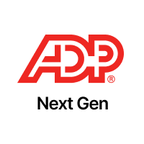Integrate ADP Workforce Now with your product—along with any other HR & payroll application
Connect your product to all the applications your customers use via Merge's Unified API to close more deals, retain customers, and expand to new markets








Sync ADP Workforce Now data
Employments
The Employment object is used to represent a job position at a company. If an integration supports historical tracking of employments, it will be reflected in the data. If not, a new Employment object will be created whenever there is a change in job title or pay. The effective_date field should be used to order Employment objects, with the most recent date corresponding to the latest employment record for an employee.
FAQ on integrating with ADP Workforce Now API
How frequently can Merge sync ADP Workforce Now data?
You can set the sync frequency based on your specific needs, which includes daily, weekly, or monthly syncs. Real-time webhooks are also supported for instantaneous updates.
Learn more about the sync frequencies you can use for a given Common Model (or one of Merge's normalized data models) here.
How does Merge interact with ADP Workforce Now's API?
Merge interacts with multiple ADP Workforce Now API endpoints to retrieve data such as employee details, locations, and time-off requests. Each interaction is mapped to specific fields like employee names, job titles, and time-off balances, ensuring that data is normalized for easy use.
Learn more about the endpoints Merge interacts with here.
How does Merge handle rate limits with ADP Workforce Now?
Merge adheres to ADP Workforce Now’s API rate limits to ensure smooth data transfers. If requests approach the limit, Merge will queue or throttle them automatically, preventing disruptions to your integration.
Can I access custom fields from ADP Workforce Now?
Yes, with Merge’s Field Mapping feature, you or your users can map custom fields from ADP Workforce Now to Merge's Common Models, ensuring you have access to the data you need. You can also use Authenticated Passthrough Request to fetch specific data not included in Merge's normalized fields or Remote Data to sync the data as it appears in a customer’s instance of ADP Workforce Now.
What other HRIS integrations can I access with Merge’s HRIS Unified API?
Merge supports over 70 HRIS integrations. Some notable integrations include BambooHR, Gusto, Workday, UKG Pro, Paycom, Namely, Rippling, Deel, and SAP SuccessFactors. That said, Merge also supports lesser-known integrations that are popular in specific regions, industries, and for companies of a certain size.
See the full list of HRIS integrations Merge supports here.
What are some common use cases for Merge’s integration with ADP Workforce Now?
Aside from auto-provisioning and deprovisioning users, Merge’s customers can use the integration in a variety of ways. Here are just a few use cases:
- A gift-giving product can detect key milestone events from the integrated data (e.g., an employee’s birthday, work anniversary, promotion, etc.), and automatically kick off the appropriate gifting workflow
- An admin in an IT management software can get alerted of a new hire and go on to select and ship their devices and equipment
- A financial modeling platform can receive employee data, including on-target earnings, to help users analyze and forecast key financial metrics—like runway, burn rate, and so on
New Year's Day - 1/1/2024Memorial Day - 5/27/20244th of July - 7/4/2024Labor Day - 9/2/2024Thanksgiving Day - 11/28/2024Day after Thanksgiving - 11/29/2024Christmas Eve - 12/24/2024Christmas Day - 12/25/2024

Trusted to power integrations at
























Make integrations your competitive advantage
More sales, less code, fewer headaches
Focus on your core product
Stop diverting your engineers to yet another integration and let them get back to work.
Give customer success a break
Manage your simplified integration issues in a single pane. No therapist required.
Stop losing sales due to integrations
Launch integrations in days, not quarters. Your sales team will thank you.
.png)

Integration authentication that feels like magic
Merge seamlessly manages authentication and authorization on behalf of your customers.
Offer account linking and permission controls to your users with Link for a customizable frontend or with Magic Link for URL-based authorization
The toolkit for all your integration needs
We make integrations painless with accessible API design, dead-simple SDKs, and beautiful documentation that we agonize over.
1from merge import Merge
2
3client = Merge(
4 account_token="YOUR_ACCOUNT_TOKEN",
5 api_key="YOUR_API_KEY",
6)
7client.hris.employees.list()import { MergeClient, Merge } from '@mergeapi/merge-node-client';
const merge = new MergeClient({
apiKey: 'YOUR_API_KEY',
accountToken: 'YOUR_ACCOUNT_TOKEN',
});
employee = await merge.hris.employees.list()
ApiClient.instance.authentications.tokenAuth = {
type: 'bearer',
accessToken: 'API_KEY',
};
new EmployeesApi().employeesList('ACCOUNT_TOKEN', {}, (data) => {
console.log(data);
});import (
"context"
"fmt"
merge "github.com/fern-api/merge-go"
mergeclient "github.com/fern-api/merge-go/client"
"github.com/fern-api/merge-go/hris"
)
client := mergeclient.NewClient(
mergeclient.ClientWithAuthApiKey("<YOUR_API_KEY>"),1ApiClient client = Configuration.getDefaultApiClient();
2client.setBasePath('https://api.merge.dev/api/ats/v1');
3ApiKeyAuth tokenAuth = client.getAuthentication('tokenAuth');
4tokenAuth.setApiKey('API_KEY');
5CandidatesApi apiInstance = new CandidatesApi(client);
6apiInstance.candidatesList('ACCOUNT_TOKEN');import com.merge.api.MergeApiClient;
import com.merge.api.resources.hris.employees.requests.EmployeesRetrieveRequest;
import com.merge.api.resources.hris.types.Employee;
MergeApiClient mergeClient = MergeApiClient.builder()
.accountToken("ACCOUNT_TOKEN")
.apiKey("API_KEY")
.build();
Employee employee = mergeClient.hris().employees().list(
EmployeesRetrieveRequest.builder()
.includeRemoteData(true)> {
"id": "0958cbc6-6040-430a-848e-aafacbadf4ae","remote_id": "19202938","employee_number": "2","company": "8d9fd929-436c-4fd4-a48b-0c61f68d6178","first_name": "Dirna","last_name": "Emanuel","display_full_name": "Dirna Emanuel",
"username": "dirnaemanuel",
"groups": [

Case study
%201%20(1).webp)
How Drata increases customer value and spends 80% less time managing integrations
Working with Merge’s Unified API and beautiful React component took less than a sprint to integrate, test, and release.
Supported HRIS platforms
Make integrations your competitive advantage
Stay in touch to learn how Merge can unlock hundreds of integrations in days, not years































































































